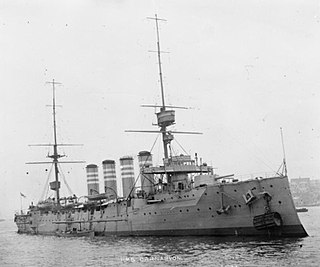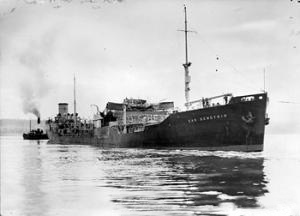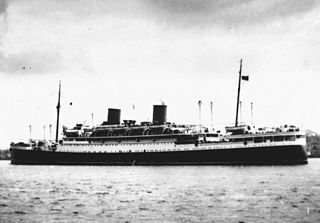
An armed merchantman is a merchant ship equipped with guns, usually for defensive purposes, either by design or after the fact. In the days of sail, piracy and privateers, many merchantmen would be routinely armed, especially those engaging in long distance and high value trade.

HMNZS Achilles was a Leander-class light cruiser, the second of five in the class. She served in the Royal New Zealand Navy in the Second World War. She was launched in 1931 for the Royal Navy, loaned to New Zealand in 1936 and transferred to the new Royal New Zealand Navy in 1941. She became famous for her part in the Battle of the River Plate, alongside HMS Ajax and HMS Exeter and notable for being the first Royal Navy cruiser to have fire control radar, with the installation of the New Zealand-made SS1 fire-control radar in June 1940.

HMS Carnarvon was one of six Devonshire-class armoured cruisers built for the Royal Navy in the first decade of the 20th century. She was assigned to the 3rd Cruiser Squadron of the Mediterranean Fleet upon completion in 1905 and was transferred to the 2nd Cruiser Squadron of the Atlantic Fleet in 1907. She was assigned to the reserve Third Fleet in 1909 and became flagship of the 5th Cruiser Squadron of the reserve Second Fleet in 1912.

Admiral Scheer was a Deutschland-class heavy cruiser which served with the Kriegsmarine (Navy) of Nazi Germany during World War II. The vessel was named after Admiral Reinhard Scheer, German commander in the Battle of Jutland. She was laid down at the Reichsmarinewerft shipyard in Wilhelmshaven in June 1931 and completed by November 1934. Originally classified as an armored ship by the Reichsmarine, in February 1940 the Germans reclassified the remaining two ships of this class as heavy cruisers.

HMS Repulse was one of two Renown-class battlecruisers built for the Royal Navy during the First World War. Originally laid down as an improved version of the Revenge-class battleship, her construction was suspended on the outbreak of war because she would not be ready in time. Admiral Lord Fisher, upon becoming First Sea Lord, gained approval for her to resume construction as a battlecruiser that could be built and enter service quickly. The Director of Naval Construction (DNC), Eustace Tennyson-d'Eyncourt, quickly produced an entirely new design to meet Admiral Lord Fisher's requirements and the builders agreed to deliver the ship in 15 months. They did not quite meet that ambitious goal, but the ship was delivered a few months after the Battle of Jutland in 1916. Repulse and her sister ship Renown were the world's fastest capital ships upon completion.

HX convoys were transatlantic convoys in the North Atlantic during the First World War and in the Battle of the Atlantic in the Second World War. HX convoys sailed eastwards from Halifax, Nova Scotia in Canada, to Liverpool and other ports in Britain. They were joined the BHX convoys from Bermuda en route. After the United States entered the war, HX convoys began at New York.

Captain Edward Stephen Fogarty Fegen, was a Royal Navy officer and a recipient of the Victoria Cross, the highest award for gallantry in the face of the enemy that can be awarded to British and Commonwealth forces.

HMS Electra was a one of nine E-class destroyers built for the Royal Navy during the 1930s. Sunk in the Battle of the Java Sea, Electra was a witness to many naval battles, including the Battle of the Denmark Strait and the sinking of Prince of Wales and Repulse. The ship's wreck was discovered in 2003 and had been badly damaged by illegal salvagers by 2016.

MV San Demetrio was a British motor tanker, notable for her service during the Second World War. She was built in 1938 for the Eagle Oil and Shipping Company. In 1940 she was damaged by enemy action in mid-Atlantic, abandoned by her crew but later re-boarded and successfully brought into harbour. She was the subject of a 1943 feature film, San Demetrio London, one of the few films that recognised the heroism of the UK Merchant Navy crews during the War.

HMS Bonaventure was the lead ship of the Dido-class light cruisers built for the Royal Navy (RN) during the 1930s and during the Second World War. Completed in 1940, Bonaventure was assigned to the Home Fleet and participated in Operation Fish, the evacuation of British wealth from the UK to Canada in July. The ship made one short patrol in August into the North Atlantic to search for German blockade runners and followed that up by escorting an aircraft carrier as it conducted air strikes in Southern Norway in September. The next month she was tasked to provide cover for anti-shipping raids off the Norwegian coast. Bonaventure participated in the unsuccessful search for the German commerce raider Admiral Scheer in November and sustained weather damage that caused her to spend time in a dockyard for repairs. She was part of the escort force for Convoy WS 5A in December and helped to drive off another German commerce raider. While searching for stragglers from the convoy, the cruiser sank a German blockade runner.

HMS York was the lead ship of her class of two heavy cruisers built for the Royal Navy in the late 1920s. She mostly served on the North America and West Indies Station before World War II. Early in the war the ship escorted convoys in the Atlantic and participated in the Norwegian Campaign in 1940. York was transferred to the Mediterranean theatre in late 1940 where she escorted convoys and the larger ships of the Mediterranean Fleet. She was wrecked in an attack by Italian explosive motorboats of the 10th Flotilla MAS at Suda Bay, Crete, in March 1941. The ship's wreck was salvaged in 1952 and subsequently scrapped.
Convoy HX 84 was the 84th of the numbered series of Allied North Atlantic HX convoys of merchant ships from Halifax, Nova Scotia, and Bermuda to Liverpool, England, during the Battle of the Atlantic. Thirty-eight ships escorted by the armed merchant cruiser HMS Jervis Bay departed from Halifax on 28 October 1940, eastbound to Liverpool.

The Action in the Strait of Otranto [also the Battle of the Strait of Otranto (1940)] was the destruction of an Italian convoy on 12 November 1940 during the Battle of the Mediterranean in the Second World War. It took place in the Strait of Otranto in the Adriatic Sea, between the Royal Navy and the Italian Royal Navy.
HX 72 was a North Atlantic convoy of the HX series which ran during the battle of the Atlantic in World War II. The convoy comprised 43 ships of which 11 were sunk and another damaged by German U-boats who suffered no losses.

San Demetrio London is a 1943 British World War II docudrama based on the true story of the 1940 salvage of the tanker MV San Demetrio by some of her own crew, who reboarded her after she had been set on fire by the German heavy cruiser Admiral Scheer and then abandoned, during the Battle of the Atlantic. The film was produced by Michael Balcon for Ealing Studios and directed by Charles Frend.

Admiral Sir Charles Edward Kennedy-Purvis was a Royal Navy officer who went on to be Deputy First Sea Lord.
Convoy HX 90 was a North Atlantic convoy of the HX series which ran during the Battle of the Atlantic in both world wars, this being a Second World War convoy.

SS Beaverford was a cargo liner registered in the United Kingdom and operated by the Canadian Pacific Steamship Company. She was built in 1928 for service between Montreal and London.

RMS Rangitiki was a passenger liner owned by the New Zealand Shipping Company. She was one of three sister ships delivered to the company in 1929 for the route between Britain and New Zealand. Rangitiki was built by John Brown & Company at Clydebank, Scotland and launched on 27 August 1928.
SS Mopan was a British steam cargo liner operated by the Fyffes Line from 1929 to 1940 until she was intercepted in mid-Atlantic and sunk by the German pocket battleship Admiral Scheer, becoming the first victim of Admiral Scheer's commerce raiding sortie.


















